The average rent being paid in newly registered tenancies nationally rose to €1,544 per month in the first quarter of this year, up almost 9 per cent on the same period last year, despite a moderate increase in supply.
The latest figures from the Residential Tenancies Board (RTB) indicate the average rent on new tenancies in Dublin, where demand is strongest, rose by 8 per cent to €2,102 per month.
The rise in rents nationally and in the capital, which coincided with an increase in the supply of new rental accommodation, underscores the affordability crisis at the heart of the State’s rental market.
The RTB’s rent index documents the prices actually paid by those taking up new tenancies in the private rental sector here rather than the asking prices advertised on websites such as Daft.ie. It does not reflect the rents being paid by existing tenants
READ MORE
The index was derived from rents paid under 14,085 private tenancies which were newly registered with the RTB in the first quarter of 2023. This represented a decrease from 15,336 in the same quarter of the previous year.
The RTB noted that Dublin and the Greater Dublin Area, accounted for over half (52.1 per cent) of all new tenancy agreements registered in the quarter. It also highlighted that nationally 58.3 per cent of all new tenancies were for apartments.
[ Rent inflation ‘stabilises’ in Dublin, Daft report showsOpens in new window ]
The highest standardised average rent in new tenancies were in Dublin (at €2,102 per month) while the lowest monthly rents were in Leitrim at €809 per month.
Some 16 counties had standardised average rents in new tenancies above €1,000 per month: Carlow, Clare, Cork, Dublin, Galway, Kerry, Kildare, Kilkenny, Laois, Limerick, Louth, Meath, Waterford, Westmeath, Wexford, and Wicklow.
The lowest yearly growth in the standardised average rent for new tenancies was in Carlow where rents grew by 2 per cent while the county with the fastest growing rent in new tenancies was Roscommon with a reported 23.7 per cent year-on-year growth.

‘We are in unchartered waters on health insurance pricing’
However, the RTB cautioned that the small number of registrations in Roscommon and other more rural, smaller rental markets can contribute to volatility in growth rates.
Some 15 counties had annualised growth in standardised average rent for new tenancies above 10 per cent, it said.
The standardised average rent in new tenancies for houses in Dublin was €2,257, an increase of 2.7 per cent on the previous quarter and a rise of 4.9 per cent year-on-year.
The average rent in new tenancies for apartments in the capital stood at €2,083 per month, an increase of 2.1 per cent on the previous quarter and a rise of 9 per cent year-on-year.
RTB rent index by county

RTB director Niall Byrne said it was “important to note that these results are for new tenancies only and therefore these insights relate to only a proportion of the overall private rental sector in Ireland.”
The national advocacy manager for the homeless support organisation Threshold, Ann-Marie O’Reilly said there has been “an unusually high increase” in rents in some parts of the country post Covid, even in rent pressure zones.
Ms O’Reilly claimed some landlords were circumnavigating rent freezes and were charging higher rents.
Properties that have been brought onto the market after being vacant for some time can set “market rent”, this was where the landlord provided proof of comparable rent in three other properties in the area.













